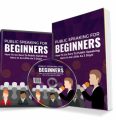Salespage Snapshot:

Table of Contents
Chapter 1:
Being an Efficient Speaker – Do You Have What It Takes?
Chapter 2:
Understanding Your Shortcomings and Overcoming Them – Training Tips
Chapter 3:
The Three Essentials to Become a Magnetic Speaker
Chapter 4:
Practically Practicing Your Speech
Chapter 5:
Coping with the Crowd – Overcoming Stage-Fright
Chapter 6:
How to Speak Onstage without Hemming and Hawing
Chapter 7:
Putting Your Point Across
Chapter 8:
The Five Essentials of a Dazzling Speech
Chapter 9:
The Most Effective Part of a Magnetic Speech – The Closing
Chapter 10:
Improving Yourself as a Speaker
Sample Content Preview
I have a friend who is often asked to speak to crowds. He speaks so much in front of crowds that no one would believe that this guy with the easy swagger on stage is actually scared to death from the prospect of getting up on that stage… even today. What makes him come onstage and deliver all those well-received speeches is that he makes it a point to have two straight shots of vodka a quarter hour before he is scheduled to speak!
Vodka may be one way to overcome stage-fright, but I surely wouldn’t recommend that for two reasons. One, it can make you slur if you cannot handle the drink, and two, you may not be able to bring about those improvisation in your speeches that we have spoken about earlier.
So what’s the next best option? Read through the following points to learn how you can tackle the problem of stage-fright in the best possible manner.
Make Eye Contact
When you get up on that stage, the first thing you must do is check out the audience. Take a short moment to glance through the audience. Look at every corner, if you can, before you begin. When you see your complete audience, a major part of your intimidation vanishes.
The same applies when you are trying to start speaking something important with someone. If you are confused on how to begin, the first thing to do is to get an eyeful of them. That puts you at ease and you can talk better.
Prepare a Thunderous Opening Line
Practice and re-practice your opening lines well. If you are starting with a quote, try saying that with different tones and modulations and see which works the best. Then go up there and deliver your best.
If you are trying to propose to someone, the same thing works. Have a great opening line ready and give it your best shot.
Any speaker gets twitchy when they have to speak to a new audience. But you must know that this twitchiness lasts for only a few initial seconds. After that, you get into the flow of the talking, considered you have prepared it well, and you don’t fumble. Hence, if your opening is well-rehearsed, you will find the nervousness pass away more quickly.
Keep Great Expressions on Your Face
Whatever it takes, don’t ever let it show that you are nervous. Keep those smiles coming and don’t frown. Speak naturally. When you look back at your speech, your affable expressions makes it look much better.
Summary
If you are not confident about what you speak, you won’t come off sounding well to the audience. Here’s how to improve your speaking by several notches.
How to Speak Onstage without Hemming and Hawing
To be effective in your speaking, you have to make sure that you speak in a flow. You should not stop midway and make embarrassing pauses while trying to think what you will say next. This is a horrible thing to do when you are onstage, for yourself and your listeners, and when you take one such pause, you feel much more worked up about the whole speech.
The best way to deliver a speech is to say it out in one shot, like it were a big monolog, and not stop midway.
So, how do you do that?
The first important thing you need to be able to speak without flinching midway is to practice your speech well. First of all, commit the speech to memory. Do it the way you like it – either mug up the entire speech or just the points, if you would like to rather work on them as you go. But, the most important practice is the speaking practice. Stand up in your room, and deliver the speech. Do it in front of a mirror. Check yourself as you say it out. You will find a hundred things you can improve on.
When you have said it once, take a pause, and then say it again in front of the mirror. You will see that the faults will have largely reduced. You will be able to speak better too. Doing this a few times really helps.
Psychologists say that people get stage-fright not because they have to deliver a speech or perform on the stage, but because they are too conscious about the way they look and the way they conduct themselves. When you practice in front of a mirror, you can correct most of these problems. In fact, you will become liking the way you conduct yourself after the first few times. This is when the speech will come across more fluently.
Later, get someone to hear you out. Tell them to criticize you openly. Work on these criticisms so that you can do better on stage. It is great if you can ask a few people to hear you delivering your speech because you could get a lot of varied feedback in that manner. Try to remove these faults.
When you are onstage, keep in mind that these are also people like you. Most of them have stage-fright too, and if they were called onstage this very moment, their legs would probably turn to jelly. You are doing a much better job. This boosts your confidence; you are able to speak much better.
Summary
Every speech is delivered because it has to make a point.
Putting Your Point Across
When you are speaking – to a single person or to a complete audience – most of the times, you are trying to make a point. You are trying to see what you are telling. At least, this is very much pronounced when you are speaking onstage. There, you are trying to make hundreds of people see things your way. Hence, it becomes very important to learn how you can put your point across.
We have already spoken a lot about the confidence factor and how you can improve upon it. It is highly important that you use these different methods and improve your confidence so that you can convince those listeners in a better way. If you are of a shaky disposition yourself, no one is going to buy what you are saying, even if it were the voice of reason.
Here are some things you must remember when you are trying to put your point across, especially when you are onstage.
Feel the Audience
A good speaker can do that. Within the first three seconds while they are onstage, they can find out whether they are speaking to a friendly audience or a hostile one. You will have to change your speech accordingly. You won’t need major changes, but if the audience is hostile, you might need to put in an example or two more. It is best you prepare for these in advance.
Start Interestingly
Your start should literally glue people onto their seats. It should grab their eyeballs. They must want to listen to you. Begin with an interesting anecdote or quote or example. If you have spoken the same thing someplace else before and it has struck a chord with the audience, then you can use a similar strategy, or even the same thing if you are sure this audience is totally different.
Make Your Point Early On
Some speakers bore their listeners to the verge of death before they come to the main point. A brisk opener is enough to set the right mood. Then go straight to the point. Make the point first and if you have more anecdotes and examples to give, work them in later.
Keep Your Physicality On
Let all those gestures, expressions, eye contact, etc. be on in their full glory. This is what rivets the audience.
Other Details- 1 Ebook (DOCX, PDF), 43 Pages
- 1 Salespage (HTML)
- Ecover (JPG)
- File Size: 745 KB














